VISUAL ARTS GRADE 12 PAPER 1 QUESTIONS - NSC PAST PAPERS AND MEMOS SEPTEMBER 2017
Share via Whatsapp Join our WhatsApp Group Join our Telegram GroupVISUAL ARTS
GRADE 12
PAPER 1
NSC PAST PAPERS AND MEMOS
SEPTEMBER 2017
INSTRUCTIONS AND INFORMATION
In this examination you must demonstrate the following skills:
- The use of the correct art terminology
- The use and implementation of visual analysing and critical thinking
- Writing and research skills within a historical and cultural context.
- The placement of specific examples within a cultural, social, political and historical context
- An understanding of characteristics/different creative styles
Read the following instructions before deciding on which questions to answer:
- This question paper consists of EIGHT questions.
- Answer any FIVE questions for a total of 100 marks.
- Questions and sub-sections must be numbered clearly and correctly according to the numbering system used in the question paper.
- Questions appear on the left-hand pages, with visual sources on the right hand pages.
- Ensure that you refer to the visual sources reproduced in colour where required.
- Information already discussed in one question, will not earn marks if repeated in other answers. Cross reference of works of art is allowed.
- Name the artist and the title of each work of art which you discuss in your answers. Underline the title of the work of art or the name of a building.
- Write clearly and legibly.
- Write in a clear, creative and structured manner, in full sentences and paragraphs, according to the instructions for each question. Bullets are not acceptable, and act only as guidelines in your essay structuring.
- A list of facts/table will NOT be accepted. Use the following guidelines for the length of your answers.
Note the mark allocation:
6–8 marks: a minimum of ½–¾ page (paragraph)
10–14 marks: a minimum of 1–1½ pages (short essay)
20 marks: a minimum of 2 pages (essay)
QUESTIONS
QUESTION 1: THE EMERGING VOICE OF BLACK ART IN THE 1950s AND 1960s
| Emerging South African artists who document daily scenes of township life either produce artworks that reflect a quiet serene atmosphere of dwellers calm endurance of their painful experiences or an atmosphere of a busy bustling activity that masks this pain. |
1.1 With reference to the visual sources shown in FIGURES 1a and 1b, write a comparative analysis of the two works (1 page) in which you discuss the following:
- Subject matter
- Composition and focal point
- The use of colour
- Style
- The atmosphere and mood
- The use of the figure(s) in each work
Which artwork do you think has the greatest visual impact? Substantiate your answer. (8)
1.2 Write an essay of at least 1½ pages in which you discuss and evaluate examples by any TWO artists you have studied and whose works reflect ordinary people going about their daily lives in a manner that expresses calm endurance of their painful experiences or an atmosphere of bustling activities that masks these experiences.
Your discussion should include the following:
- Name of artist(s) and artworks
- Subject matter
- Use of compositional devices
- Formal elements
- Style and techniques
- Message conveyed (12)
[20]
| FIGURE 1a: Louis Maqhubela, Township Scene, oil on board, 1961. |
| FIGURE 1b: Peter Clarke, Wind blowing on Cape Flats, gouache, 1960. |
QUESTION 2: SOUTH AFRICAN ARTISTS INFLUENCED BY AFRICAN AND INDIGENOUS ART FORMS
| Influences from different cultures and styles can be seen in both Alexis Preller’s (FIGURE 2a) and Walter Battis’ (FIGURE 2b) artwork. |
2.1 Refer to FIGURE 2a and FIGURE 2b. Analyse and discuss these works in an essay of at least 1–1½ pages.
Refer to the following:
- Subject matter
- Symbols
- Formal elements
- Style
- Composition (10)
2.2 Choose and interpret any TWO works by any other artist(s) you have studied, whose work has been influenced by African/indigenous art forms (1 page).
Refer to the following:
- Name of artists and titles of the work
- Influences
- Visuals that relate to Africa-/indigenous artforms
- Use of material and style
- Content and meaning (10)
[20]
| FIGURE 2a: Alexis Preller, The Kraal, oil on canvas, date unknown. |
| FIGURE 2b: Walter Battis, Fishermen drawing nets, oil on canvas, 1955. |
QUESTION 3: ART AND POLITICS – RESISTANCE ART
| Although 1994 officially marked the end of institutionalised racism, racism is still prevalent among different social-political spheres manifesting itself in various forms. |
FIGURE 3a reflects on the exploitation of cheap black labour during apartheid.
3.1 Study the visual source FIGURE 3a and in a paragraph discuss how this work reflects abuse and exploitation of cheap Black labour:
Refer to the following:
- The choice of images
- Subject matter and media
- Composition
- Meaning and interpretation (6)
3.2 FIGURE 3b was inspired by the news video of brutal treatment of Black migrant labour from outside the country. The installation is accompanied by a sound track of the dogs barking. The visual illustration is a reconstituted arrangement of still clips to describe the incident.
Study the visual illustration and in a paragraph of about ½-–¾ page answer the following:
- Describe and explain what you perceive to have happened
- Discuss the different aspects of the medium used and how they enhance the message
- How the title adds to the message conveyed (6)
3.3 Choose ONE specific artwork that you have studied that make us aware of the injustices in our past and present. Discuss this works in detail (1 page).
Refer to the following:
- Name of the artist and title of the artwork
- Subject matter
- Influences
- Media and technique
- Stylistic characteristics
- Success of art as a tool for making us aware of the injustice (8)
[20]
| FIGURE 3a: Manfred Zylla, Games, Acrylic paint on hessian, 1985. |
| | |
| Video stills | Detail |
| FIGURE 3b: Willie Bester, Who let the dogs out?, sculpture installation, 2001. |
QUESTION 4: ART, CRAFT AND SPIRITUAL WORKS MAINLY FROM RURAL SOUTH AFRICA
| Many rural black South African artists have been influenced by Christianity which has been combined with traditional spiritual beliefs and customs. |
4.1. With reference to the statement above, analyse and interpret the given illustration FIGURE 4a by writing an essay of ½-–¾ page. Refer to the following in your essay:
- Influences
- Medium and technique
- Subject matter
- Composition
- Style and significance of the text
- Meaning of the artwork (7)
FIGURE 4b is a shrine figurine and is therefore supposed to be enclosed in a shrine for religious purposes. The sculpture would be regarded as a power figure and the tribal people would pray to her and offer her gifts.
4.2 Discuss the forms and features of the sculpture that render it a typical rural African carving and show how the posture of figurine speaks of its spiritual power. (6)
4.3 Refer to FIGURE 4c. Credo Mutwa merges culture and nature which led him to be defined as an ‘indigenous environmentalist’.
With the above in mind, define the characteristics of the statue within the context of the following:
- Title
- Scale
- Site
- Forms and features (4)
4.4 Review the three visual illustrations. How is the notion of procreation emphasised in the three artworks? (3)
[20]
| FIGURE 4a: John Muafangejo, Untitled, Lino print. |
| FIGURE 4b: Shrine Figure, Yoruba, Nigeria, wood, late 19th century. |
| FIGURE 4c: Credo Mutwa, Earth Mother, cement, Shamwari Game Reserve. |
QUESTION 5: MULTI-MEDIA AND NEW MEDIA – ALTERNATIVE CONTEMPORARY AND POPULAR ART FORMS IN SOUTH AFRICA
| “It’s very easy to say, ‘I could have done that,’ after someone’s done it. But I did it. It didn’t exist until I did it.” – Damien Hirst |
5.1 With reference to the above statement and visual source FIGURE 5a, write a paragraph (at least ½ page) in which you discuss the artwork considering the following:
- The medium used
- The message of the artwork (4)
5.2 Also with reference to the above statement analyse and discuss FIGURE 5b in essay format (at least ¾ page). Consider the following:
- Application of art elements and principles
- Mediums relevant to the concept
- Meaning or message (6)
5.3 For this question, you may not use a work which appears in this question paper. However, you may use a different work by one of the artists used in this paper.
In essay format, of at least ONE page, recall, discuss and compare at least TWO works in multimedia which you have studied, substantiating each of the following:
- Name the work(s) as well as the artist
- Media
- Messages and/or meanings
- Influenced by which style of art
- Presentation (10)
[20]
| FIGURE 5a: Damien Hirst, The Physical Impossibility of Death in the Mind of Someone Living, 1991. |
| FIGURE 5b: Damien Hirst, FOR THE LOVE OF GOD. |
QUESTION 6: POST-1994 – DEMOCRATIC IDENTITIY IN SOUTH AFRICA
| Post-Apartheid visual art made definite contributions with regards to the integration and emancipation of different races in South Africa. This led to a believable, contemporary South Africa in which artists could once again focus on reviewing their own identities. |
In FIGURES 6a and 6b Thembinkosi Goniwe and Churchhill Madika critically deals with the issue of identity as a social construct respectively. While Goniwe deals with contemporary “unspoken racial constructs” that are visible today, Madika questions imposed Amaxhosa traditions that infringe on one’s freedoms.
6.1 With the above in mind, write an essay of about ¾ of a page in which you discuss how each artist deals with his issue in the visual sources.
Refer to the following:
- Mediums used
- Style and technique
- The commentary these artists make
- Which one makes the strongest impact, with reasons for your choice (8)
6.2 Write an essay of at least 1½ page, discussing the work of any TWO South African artists you have studied, who question and reflect on their post-1994 identity. Refer to specific works of art in you answer, which do not appear on this question paper. (12)
[20]
| GLOSSARY Contemporary art: Art from the 1970s to today |
| FIGURE 6a: Thembinkosi Goniwe, Untitled, Billboard as part of the Returning the Gaze Project, Cape Town, 2000. |
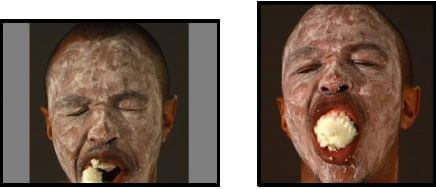 |
| FIGURE 6b: Churchill Madikida, Struggles of the heart, C-Prints stills from video, 2003. |
QUESTION 7: GENDER ISSUES
| FIGURE 7a is a self-portrait by the artist Frida Kahlo. The Mexican artist’s personal life and history is directly portrayed in her art. Her work bears harrowing witness to her own physical and mental suffering. Nandipha Mntambo’s work ‘Emabutfo’ on the other hand deals with representation and perception of the female body. |
7.1 With reference to the statement above and Figures 7a and 7b, discuss the possible meanings of these two works and how their work pertain to gender issues and gender identity. Refer to the following:
- Use of title
- Subject matter
- Composition
- Style and approach (8)
7.2 Write an essay of at least 1½ pages, discussing the work of any TWO artists you have studied, who question gender identity. Refer to specific works of art in you answer, which do not appear in this question paper. (12)
[20]
| GLOSSARY Emabutfo: Warriors from the Swazi regiments to the royal residence of the king. |
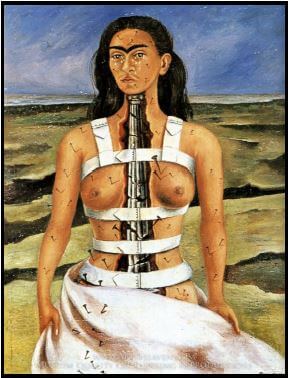 |
| FIGURE 7a: Frida Kahlo, The broken column, oil on canvas, 1944. |
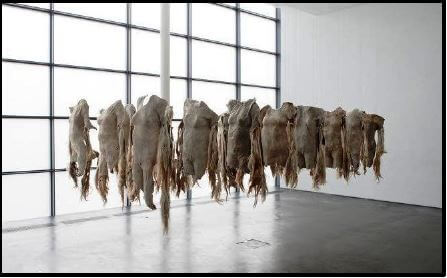 |
| FIGURE 7b: Nandipha Mntambo, Emabutfo, cowhide, resin, polyester mesh and waxed cord, 2009. |
QUESTION 8: ARCHITECTURE IN SOUTH AFRICA
| “Africa is land under construction and local talent have stepped forward to shape the landscape. There is a lot of very good indigenous knowledge on the continent.” says Iain Low, professor of architecture at the University of Cape Town. |
8.1 Considering the above-mentioned, study FIGURE 8a and 8b, and consider its relevance in its own time as an example of innovative architecture. Write an essay of ONE page, in which you evaluate the innovative accomplishments. You may include thoughts on the following:
- Principles of design applied
- Influences and creative thought
- Peculiar characteristics
- Aims and effective functionality (8)
8.2 In an essay of approximately 1½ pages, clearly analyse TWO commemorative structures a South African architect(s). Discuss the shapes, materials and design which place them in a category of outstanding impact.
The following aspects may well be relevant:
- Names of architects/companies and buildings
- Special features
- Peculiar materials, technology and design
- Ecological considerations
- Environmental issues
- Functionality (12)
[20]
| GLOSSARY Commemorative structures: A structure that has been erected to remember the past, to respect great personalities and symbolise a new future. Exhibitions, libraries, interactive areas and public gathering spaces. |
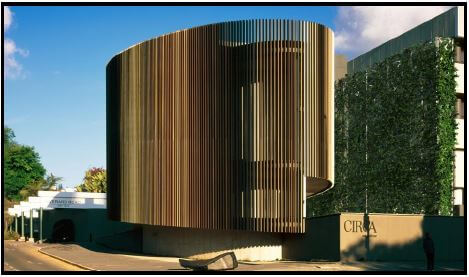 |
| FIGURE 8a: Pierre Swanepoel, Studiomas Architecture, Circa Building. |
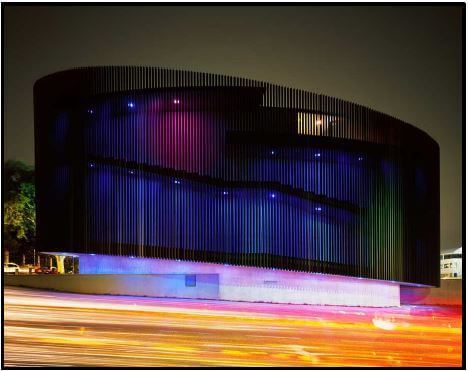 |
| FIGURE 8b: Pierre Swanepoel, Studiomas Architecture, Circa Building, night time. |
TOTAL: 100